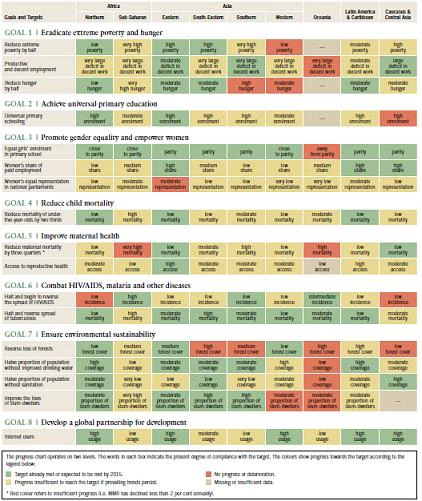Secretary General Ban-ki Moon released the 11th annual report on Millennium Development Goals last Friday at the high level meeting of the Economic and Social Council in Geneva (MDG 2011). Issuing an annual report on progress toward the MDGs was a commitment made by his predecessor, Kofi Annan. Taken together, these yearly reports provide a freeze-frame, slow-motion picture of the social and economic tides of the past two decades. And like the tides the movement has been subtle, rising in some places and falling in others, but on the whole there has been a sea change, marked by decreasing poverty, improved school enrollments, lower mortality rates, and improved statistics.
A Brief history of the MDGs
The Millennium Declaration, adopted unanimously at the Millennium Summit of the United Nations in September 2000, was not the first effort to mobilize global action to end poverty and advance development. Nor was it the first to set targets and name indicators to monitor them. Over the decade of the 1990s UN summits and conferences -- on education, gender, social development, and the environment -- all adopted lofty and, perhaps, unreachable targets. But as much as they are debated in prospect, outcome documents have a way of being quickly forgotten.
In 1966 the OECD Development Assistance Committee published “Shaping the 21st Century: The Role of Development Cooperation”, which distilled a set of seven quantified and time-bound goals from the summits records. Saying, in effect, this is what success would look like, the published goals challenged aid donors and developing countries to make good on their commitments. They also challenged statisticians to improve the data for measuring progress toward the targets.
The effort to measure the progress toward these goals gave rise to the creation of Paris 21 (Partnership in Statistics for Development in the 21st Century) and the first report signed jointly by the heads of the OECD, UN, IMF and World Bank: A Better World for All, which conveyed in words, pictures, and statistics the simple message that development progress is possible.
The MDG Report
Today’s MDG Report continues that tradition. It is a cooperative exercise among 27 international organizations, funds, programs, and commissions, which meet as the Interagency and Expert Group on the MDGs. The UN Statistics Division serves as secretariat to the group and editor and publisher of the report on behalf of the Secretary General. Besides authoring the report, the IAEG provides a forum for coordinating statistical work across the agencies and engaging national statistical offices in the creation of a comprehensive MDG database.
And what does this year’s report say? It notes progress in poverty reduction, in school attendance, in reducing maternal deaths and in increasing access to clean water and tackling HIV/AIDS and other debilitating diseases. Yet it also highlights that progress on the MDGs has been alarmingly slow for people at the bottom of the economic ladder as well as for those who are disadvantaged because of their sex, age, disability or ethnicity. In addition, disparities between urban and rural areas are daunting – over 800 million people live in slums today and improving the lives of the urban poor is an urgent concern. In rural areas, over 3.6 billion people still lack access to flush toilets or other forms of improved sanitation and access to safe drinking water in rural areas is woefully insufficient . Also, ecosystems are under stress and not being protected for future generations. With only four years to go, too many people are hungry, out of a job or fearing they will be laid off. And many are buffeted by conflicts, natural disasters or volatile food and energy prices.
This is not the only report on the MDGs issued each year. At the World Bank we produce at least two: the Global Monitoring Report (GMR) and the World Development Indicators. Each has its own niche. The GMR looks at the policies and actions needed to make progress toward the MDGs. The World View section of the WDI documents statistical progress and provides access to a broad array of data measuring the social and economic conditions of the world and its people. Also worth a look is the MDG Gap Taskforce Report, a collaborative report by UN agencies on Goal 8: Creating a global partnership for development.
MDG Progress Chart
Click here to see a larger version of this MDG progress chart.



Join the Conversation